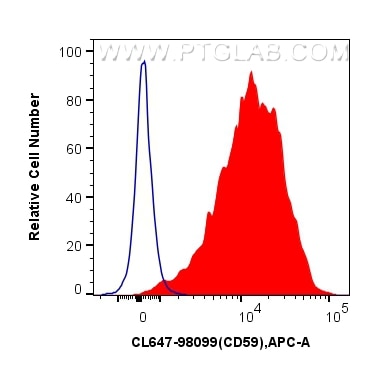CD59 Rekombinanter Antikörper
CD59 Rekombinant Antikörper für FC
Wirt / Isotyp
Kaninchen / IgG
Getestete Reaktivität
human
Anwendung
FC
Konjugation
CoraLite® Plus 647 Fluorescent Dye
CloneNo.
241311A4
Kat-Nr. : CL647-98099
Synonyme
Geprüfte Anwendungen
| Erfolgreiche Detektion in FC | humane PBMCs |
Empfohlene Verdünnung
| Anwendung | Verdünnung |
|---|---|
| This reagent has been pre-titrated and tested for flow cytometric analysis. The suggested use of this reagent is 5 ul per 10^6 cells in a 100 µl suspension or 5 ul per 100 µl of whole blood. | |
| Sample-dependent, check data in validation data gallery | |
Produktinformation
CL647-98099 bindet in FC CD59 und zeigt Reaktivität mit human
| Getestete Reaktivität | human |
| Wirt / Isotyp | Kaninchen / IgG |
| Klonalität | Rekombinant |
| Typ | Antikörper |
| Immunogen | Rekombinantes Protein |
| Vollständiger Name | CD59 molecule, complement regulatory protein |
| Berechnetes Molekulargewicht | 19 kDa |
| GenBank-Zugangsnummer | BC001506 |
| Gene symbol | CD59 |
| Gene ID (NCBI) | 966 |
| Konjugation | CoraLite® Plus 647 Fluorescent Dye |
| Excitation/Emission maxima wavelengths | 654 nm / 674 nm |
| Form | Liquid |
| Reinigungsmethode | Protein-A-Reinigung |
| Lagerungspuffer | PBS with 0.09% sodium azide and 0.5% BSA |
| Lagerungsbedingungen | Store at 2-8°C. Avoid exposure to light. Stable for one year after shipment. |
Hintergrundinformationen
CD59, also named as MIC11, MIN1, MIN2, MIN3, MSK21, MIRL, MACIF, HRF20 and 1F5 antigen, is a cell surface molecule glycoprotein with MW 18-25 kDa. It acts as a determinant of proximal-distal cell identity. CD59 acts by binding to the C8 and/or C9 complements of the assembling membrane attack complex (MAC), thereby preventing incorporation of the multiple copies of C9 required for complete formation of the osmolytic pore. It is involved in signal transduction for T-cell activation complexed to a protein tyrosine kinase.
Protokolle
| PRODUKTSPEZIFISCHE PROTOKOLLE | |
|---|---|
| FC protocol for CL Plus 647 CD59 antibody CL647-98099 | Download protocol |
| STANDARD-PROTOKOLLE | |
|---|---|
| Klicken Sie hier, um unsere Standardprotokolle anzuzeigen |



